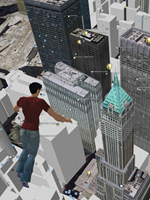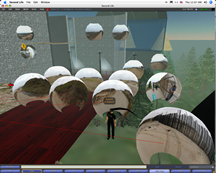Nov 26, 2007
Vodafone "InsideOut" connects phones to Second Life

Vodafone offers a new service called "InsideOut" that allows interaction between characters in Second Life and real phones.
"Both voice calls and text messages can be ferried in and out of the game, with SMSes running a cool L$300 (around $1) and voice calls running L$300 per minute.
Calls and messages placed to Second Life, though, are billed at the same rate as they would be to a traditional German phone."
00:09 Posted in Virtual worlds, Wearable & mobile | Permalink | Comments (0) | Tags: virtual reality, second life, mobile
Oct 21, 2007
AjaxLife
A new application called AjaxLife allows browser-based interaction with the online virtual world SecondLife.
Using AjaxLife, users do not need a video card and a graphical client to connect to the SecondLife world. However, the AjaxLife client supports only limited functions, such as in-game chatting, teleporting to various locations and checking the status of the user's inventory, friends and Linden Dollars, and there is no representation of in-game avatars.
The web application was developed by Katharine Barry, a fifteen (!) year old English schoolgirl.
23:45 Posted in Virtual worlds | Permalink | Comments (0) | Tags: second life
Jun 24, 2007
Toward a Metaverse

In this interesting article recently published in Technology Review, Wade Roush predicts that the line between the real world and its virtual representations will soon start blurring. Here is an excerpt from the article:
[...] The first, relatively simple step toward a Second Earth, many observers predict, will be integrating Second Life's avatars, controls, and modeling tools into the Google Earth environment. Groups of users would then be able to walk, fly, or swim across Google's simulated landscapes and explore intricate 3-D representations of the world's most famous buildings ... A second alternative would be to expand the surface area of Second Life by millions of square kilometers and model the new territory on the real earth, using the same topographical data and surface imagery contained in Google Earth ... That's a much more difficult proposition ...
[W]ithin 10 to 20 years--roughly the same time it took for the Web to become what it is now--something much bigger than either of these alternatives may emerge: a true Metaverse ... It will look like the real earth, and it will support even more users than the Snow Crash cyberworld, functioning as the agora, laboratory, and gateway for almost every type of information-based pursuit. It will be accessible both in its immersive, virtual-reality form and through peepholes like the screen of your cell phone as you make your way through the real world. And like the Web today, it will become "the standard way in which we think of life online..."
While Second Life and Google Earth are commonly mentioned as likely forebears of the Metaverse, no one thinks that Linden Lab and Google will be its lone rulers. Their two systems are interesting mainly because they already have many adherents, and because they exemplify two fundamentally different streams of technology that will be essential to the Metaverse's construction...
"Google Earth itself is really neat," comments Jamais Cascio, the Metaverse Roadmap coauthor. "But Google Earth coupled with millions of sensors around the world, offering you real-time visuals, real-time atmospheric data, and so on--that's transformative."
Indeed, it's important to remember that alongside the construction of the Metaverse, a complementary and equally ambitious infrastructure project is under way. It's the wiring of the entire world, without the wires: tiny radio-connected sensor chips are being attached to everything worth monitoring, including bridges, ventilation systems, light fixtures, mousetraps, shipping pallets, battlefield equipment, even the human body ... "Augmented reality and sensor nets will blend right into virtual worlds," predicts Linden Lab's Ondrejka. "That's when the line between the real world and its virtual representations will start blurring."
23:30 Posted in Virtual worlds | Permalink | Comments (0) | Tags: virtual worlds, second life
Jan 25, 2007
Second Life gets virtual mobile operator
From Textually.org

Vodafone is planning to launch itself as a mobile operator in the game Second Life alongside its Vodafone Island area within the popular virtual world, reports TechDigest
"Second Life users will be able to use branded handsets to call each other within the world, as well as send text messages."
Second Life Cell Phones can SMS real world Phones
22:06 Posted in Virtual worlds, Wearable & mobile | Permalink | Comments (0) | Tags: virtual reality, second life
Jan 07, 2007
Imaging Place SL: The U.S./Mexico Border
Re-blogged from Networked Performance

Imaging Place SL: The U.S./Mexico Border by John (Craig) Freeman: Jan 5 - Feb 23, 2007: Ars Virtua: Gallery 2: Opening 7 - 9pm SLT(Pacific Time) Friday January 5, 2007. Go there
"Imaging Place," is a place-based, virtual reality art project. It takes the form of a user navigated, interactive computer program that combines panoramic photography, digital video, and three-dimensional technologies to investigate and document situations where the forces of globalization are impacting the lives of individuals in local communities. The goal of the project is to develop the technologies, the methodology and the content for truly immersive and navigable narrative, based in real places. For the past several months, Freeman has been implementing the "Imaging Place" project in Second Life.
When a denizen of Second Life first arrives at an Imaging Place SL Scene he, she or it sees on the ground a large black and white satellite photograph of the full disk of the Earth. An avatar can then walk over the Earth to a thin red line which leads to an adjacent higher level platform made of a high resolution aerial photograph of specific location from around the world. Mapped to the aerial images are networks of nodes constructed of primitive spherical geometry with panoramic photographs texture mapped to the interior.
The avatar can walk to the center of one of these nodes and use a first person perspective to view the image, giving the user the sensation of being immersed in the location. Streaming audio is localized to individual nodes providing narrative content for the scene. This content includes stories told by people who appear in the images, theory and ambient sound. When the avatar returns to the Earth platform, several rotating ENTER signs provide teleports to other "Imaging Place" scenes located at other places within the world of Second Life. In "Imaging Place SL: The U.S./Mexico Border," Freeman explores the issues, politics and personal memories of this contested space.
LIVE PERFORMANCE by Second Front: Friday, January 05, 2007 - 7 PM PST Second Front is the first dedicated performance art group in Second Life. To officially open JC Fremont's Installation at Ars Virtua, Second Front will be creating a realtime interpretive and site-specific performance based on JC Fremont's theme 'Borders' to compliment "Imaging Place SL: The U.S./Mexico Border."
23:32 Posted in Cyberart, Virtual worlds | Permalink | Comments (0) | Tags: second life
Dec 22, 2006
Second Life avatars consume as much electricity as Brazilians
From 3Dpoint
Nick Carr calculates that a Second Life avatar consumes as much electricity as a Brazilian:
If there are on average between 10,000 and 15,000 avatars "living" in Second Life at any point, that means the world has a population of about 12,500. Supporting those 12,500 avatars requires 4,000 servers as well as the 12,500 PCs the avatars' physical alter egos are using. Conservatively, a PC consumes 120 watts and a server consumes 200 watts. Throw in another 50 watts per server for data-center air conditioning. So, on a daily basis, overall Second Life power consumption equals... 60,000 kilowatt-hours....
Which, annualized, gives us [an average avatar consumption of] 1,752 kWh. So an avatar consumes 1,752 kWh per year..... [T]he average citizen of Brazil consumes 1,884 kWh, which, given the fact that my avatar estimate was rough and conservative, means that your average Second Life avatar consumes about as much electricity as your average Brazilian.
Which means, in turn, that avatars aren't quite as intangible as they seem. They don't have bodies, but they do leave footprints.
00:25 Posted in Virtual worlds | Permalink | Comments (0) | Tags: second life






